Star Wars Episode VII: The Force Awakens (2015, Dir. J.J. Abrams):
Warning: Some spoilers ahead.
J.J. Abrams and Star Wars have been destined to meet since that scene in his Star Trek reboot (2009) in which young, rebellious, landlocked Jim Kirk gazes upon the bones of a starship under construction, and dreams of adventures beyond his reach. With that one moment, Abrams betrayed where his real sentiments lie — not with the speculative, philosophical sci-fi overtones of Trek, but with the epic fantasy-driven mythologizing of Star Wars, particularly that bit with Luke Skywalker and the twin sunset. By the time Kirk and gang were outmaneuvering Klingon attack ships with Millennium Falcon-worthy acrobatics in Abrams’ Star Trek: Into Darkness (2013), the die was all but cast for Abrams to assume the helm for Star Wars‘ rebirth. With the franchise now in Disney’s stable (and a multitude of one-off movies and sequels in the works), a lot was riding on Star Wars: Episode VII to make the right impression, which meant erasing the bitter taste of George Lucas’ stilted prequel trilogy from our mouths. A self-admitted fanboy, Abrams has spearheaded what one might call the victory of the nerds. No longer are our pop culture franchises being administered by out-of-touch overlords (aka George Lucas), but by acolytes who grew up on the stuff and can probably recite the dialogue better than the folks who originally wrote it. “This will begin to make things right,” are the first words uttered in the movie, by no less than Max von Sydow, and the gauntlet is thrown down. You’re out of here, George! Time to have some fun again!
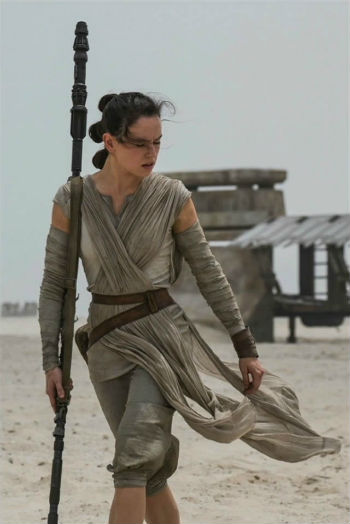 And fun Star Wars: The Force Awakens is, as Yoda might say — or at least, it’s more fun than the prequels. Abrams has three primary weapons in his cinematic arsenal, and he deploys all of them here. As a director, he’s a chameleon (or a copycat if you’re in a less charitable mood) who has an intuitive feel for his idols’ styles. Thus we have the early-’80s Spielberg vibe in Abrams’ adolescents-meet-extraterrestrials flick Super 8, and for The Force Awakens he’s gone all the way back to Lucas circa 1977 for inspiration: practical sets and effects, shooting on 35mm instead of digital, more effort to balance human interaction with sparkly setpieces. Abrams also is hyper-aware of audience expectations, and simultaneously honors and subverts them. Like a dealer shuffling a stacked deck of cards into different configurations, he gives you everything you remember loving, but with a tweak each time, to provide the illusion of freshness if nothing else. Remember when Princess Leia was captured at the beginning of the first movie? What if we did the same thing with the hotshot pilot this time around? Or: Remember when the lead villain turned out to be the hero’s father in the original trilogy? What if he turned out to be a hero’s son this time? Finally, as you would expect from the executive producer of Lost, Abrams is enamored with the idea of a central mystery driving the action. From the very first words of the title crawl, it’s spelled out for us: Luke Skywalker has vanished.
And fun Star Wars: The Force Awakens is, as Yoda might say — or at least, it’s more fun than the prequels. Abrams has three primary weapons in his cinematic arsenal, and he deploys all of them here. As a director, he’s a chameleon (or a copycat if you’re in a less charitable mood) who has an intuitive feel for his idols’ styles. Thus we have the early-’80s Spielberg vibe in Abrams’ adolescents-meet-extraterrestrials flick Super 8, and for The Force Awakens he’s gone all the way back to Lucas circa 1977 for inspiration: practical sets and effects, shooting on 35mm instead of digital, more effort to balance human interaction with sparkly setpieces. Abrams also is hyper-aware of audience expectations, and simultaneously honors and subverts them. Like a dealer shuffling a stacked deck of cards into different configurations, he gives you everything you remember loving, but with a tweak each time, to provide the illusion of freshness if nothing else. Remember when Princess Leia was captured at the beginning of the first movie? What if we did the same thing with the hotshot pilot this time around? Or: Remember when the lead villain turned out to be the hero’s father in the original trilogy? What if he turned out to be a hero’s son this time? Finally, as you would expect from the executive producer of Lost, Abrams is enamored with the idea of a central mystery driving the action. From the very first words of the title crawl, it’s spelled out for us: Luke Skywalker has vanished.
The importance of finding Luke is mentioned often as the film unfolds, but like many of Abrams’ other movies, the mystery is ultimately a McGuffin. What really matters is the dialogue between past and present: how the early scenes on the desert planet Jakku deliberately echo the passages on Tatooine in the original Star Wars, how the movie’s new array of characters speak in hushed tones of the events of episodes IV-VI as if they are half-forgotten myths, much like the half-buried star destroyers and Imperial walkers scattered about Jakku’s surface. Just as our new hero Rey (Daisy Ridley) scavenges these ancient artifacts for parts, Abrams is scavenging the Star Wars mythos for whatever he finds useful. The Force Awakens is essentially a remake of Star Wars Episode IV: A New Hope: bad guys seek critical information, the data is hidden within a lovable droid, droid meets up with an innocent hero, hero gets sucked into a galactic whirlwind of intrigue while coming to know about this thing called The Force. Just substitute “The First Order” for the Empire and “The Resistance” for the Rebellion and we might as well be 38 years in the past. Abrams doesn’t have the eye for composition of vintage Lucas, and he’s less inclined to delve into the mysticism of The Force than his predecessor (we’re talking Yoda, not midochlorians), but he does a credible job of approximating the lived-in feel of the classic trilogy. Speaking of which, we’re constantly bombarded with reminders of what’s come before, whether they’re overt (Welcome back, Millennium Falcon! Greetings, Han and Chewie and Leia and R2 and 3PO and Admiral Ackbar!) or nudge-nudge, wink-wink (“Is there a garbage chute? A trash compactor?” Han asks a confederate when the latter asks what they should do with a captured baddie). Rest assured, you’ll hear someone say, “I’ve got a bad feeling about this.”
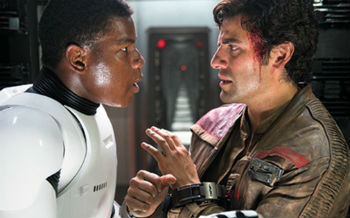 This might all sound like a rote exercise in nostalgia, but Abrams changes a few things up. In acknowledgment that we live in a Benetton world, our three new leads are a woman (Ridley), a black man (John Boyega) and a Latino-American (Oscar Isaac). This could have come off as a cynical appeal to demographics; fortunately Abrams and his actors are good enough to earn our approval. (In fairness, it should be noted that there’s also a cantina crammed with funny-looking aliens doing Jamaican reggae, which might raise some folks’ hackles.) Rey is a bit sketchy as a character, with mysteries about her background left for future entries to resolve, and Ridley tends to overdo it when she’s called upon for teeth-gritting intensity, but she’s a far more robust, sympathetic hero than anyone from Lucas’ prequel trilogy. Isaac provides a dash of derring-do as hotshot pilot Poe (although he’s ultimately most memorable for piloting a black X-wing — what, you thought Disney wouldn’t take advantage of the merchandising opportunities?), while Boyega provides most of the film’s charm as Finn, a stormtrooper who decides to defect to the good guys. Antsy yet good-hearted, he’s the closest to an audience surrogate with his “let’s get out of here” reactions to every perilous situation. “Are you ready for this?” he’s asked at one juncture. His response, tossed-off and to-the-point: “Hell no.” The growing camaraderie between our three heroes is a bit forced amidst the rush of the plot, but all three actors seem primed to build on their performances here.
This might all sound like a rote exercise in nostalgia, but Abrams changes a few things up. In acknowledgment that we live in a Benetton world, our three new leads are a woman (Ridley), a black man (John Boyega) and a Latino-American (Oscar Isaac). This could have come off as a cynical appeal to demographics; fortunately Abrams and his actors are good enough to earn our approval. (In fairness, it should be noted that there’s also a cantina crammed with funny-looking aliens doing Jamaican reggae, which might raise some folks’ hackles.) Rey is a bit sketchy as a character, with mysteries about her background left for future entries to resolve, and Ridley tends to overdo it when she’s called upon for teeth-gritting intensity, but she’s a far more robust, sympathetic hero than anyone from Lucas’ prequel trilogy. Isaac provides a dash of derring-do as hotshot pilot Poe (although he’s ultimately most memorable for piloting a black X-wing — what, you thought Disney wouldn’t take advantage of the merchandising opportunities?), while Boyega provides most of the film’s charm as Finn, a stormtrooper who decides to defect to the good guys. Antsy yet good-hearted, he’s the closest to an audience surrogate with his “let’s get out of here” reactions to every perilous situation. “Are you ready for this?” he’s asked at one juncture. His response, tossed-off and to-the-point: “Hell no.” The growing camaraderie between our three heroes is a bit forced amidst the rush of the plot, but all three actors seem primed to build on their performances here.
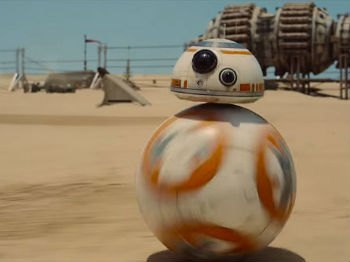 For much of The Force Awakens‘ running time, there’s enough bits to keep us entertained. As always, Abrams is an accomplished table-setter: the movie’s opening act is relaxed yet efficient at introducing our lead characters. Thanks to Lawrence Kasdan, who co-wrote episodes V and VI, much of the dialogue has the potboiler zing of the old days. “Stay calm, stay calm,” Finn mutters as he and Poe attempt an escape. “I am calm,” Poe snaps. “I was talking to myself,” Finn replies. Poe’s BB-8 droid might be R2-D2 redux, but it’s a marvel of a design, rolling and bopping madly about, and its relationship with Rey is surprisingly heart-warming. While the bad guys don’t get much screentime or development (Andy Serkis’s Supreme Leader Snoke mostly lurks in the shadows in this episode), Adam Driver emerges as the movie’s wild card as Kylo Ren, the central villain. His abilities are never clearly mapped out (early on he freezes a laser bolt in midair with the Force, but at other crucial junctures he seems near-powerless), and his schizoid personality swings (one instant he’s fearsome, and in the next he’s a punchline as he throws a temper tantrum, nearby stormtroopers slowly backing away) don’t mark him as the most imposing of bad guys, but Driver, with his soft voice and Picasso lips, drenches him in ambiguity and vulnerability. In a movie where everyone else fits into standard Star Wars cookie-cutter character molds, he stands out as the sole unpredictable element.
For much of The Force Awakens‘ running time, there’s enough bits to keep us entertained. As always, Abrams is an accomplished table-setter: the movie’s opening act is relaxed yet efficient at introducing our lead characters. Thanks to Lawrence Kasdan, who co-wrote episodes V and VI, much of the dialogue has the potboiler zing of the old days. “Stay calm, stay calm,” Finn mutters as he and Poe attempt an escape. “I am calm,” Poe snaps. “I was talking to myself,” Finn replies. Poe’s BB-8 droid might be R2-D2 redux, but it’s a marvel of a design, rolling and bopping madly about, and its relationship with Rey is surprisingly heart-warming. While the bad guys don’t get much screentime or development (Andy Serkis’s Supreme Leader Snoke mostly lurks in the shadows in this episode), Adam Driver emerges as the movie’s wild card as Kylo Ren, the central villain. His abilities are never clearly mapped out (early on he freezes a laser bolt in midair with the Force, but at other crucial junctures he seems near-powerless), and his schizoid personality swings (one instant he’s fearsome, and in the next he’s a punchline as he throws a temper tantrum, nearby stormtroopers slowly backing away) don’t mark him as the most imposing of bad guys, but Driver, with his soft voice and Picasso lips, drenches him in ambiguity and vulnerability. In a movie where everyone else fits into standard Star Wars cookie-cutter character molds, he stands out as the sole unpredictable element.
The Force Awakens‘ clear highlight, though, is the return of Harrison Ford as Han Solo. For the first time in what seems like a very long time, Ford is fully engaged, and even though Abrams and Kasdan saddle him with a heavy backstory, he’s rarely been more graceful than he is here. He doesn’t necessarily have all that much to do besides slinging wisecracks, having fun with Chewbacca’s cross-bow laser rifle, and pal-ing around with Rey and Finn, but he ends up stealing the show, anyway. When Han is reunited with Leia (Carrie Fisher gives it her best, but it’s sad to see that her once-snappy timing has been eroded by age) and she says, “I always hated watching you leave,” he responds with that familiar half-smirk, “That’s why I did it… so you’d miss me.” It’s a moment that would melt the hardest of hearts.
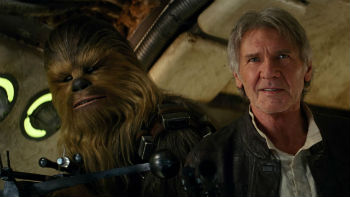 Finn: We’ll figure it out, we’ll use the force!
Finn: We’ll figure it out, we’ll use the force!
Han Solo: That’s not how the force works!
With all the above, you might assume that The Force Awakens is Mission Accomplished for Abrams and crew, Star Wars resuscitated and triumphant for a new generation. Sadly, not quite. It’s easy to diminish Lucas’ accomplishments these days based on the travesty of the prequels. You could also say that the original Star Wars movies were the product of a particular time and place, and that it would be futile to expect to recapture the old feeling. But in those first films Lucas achieved something unique that still holds up today: he created a child-like throwback to old adventure serials that also managed to tap into something with emotional resonance. The strengths and flaws of The Force Awakens are nearly a perfect match with early Star Wars: the cheesy banter, the simplistic plot, the soaring John Williams score, the state-of-the-art effects, the self-indulgent universe-building. What’s missing is the dramatic shape that Lucas gave the original trilogy. Whatever else you can say about the first few films, their emotional course was always crystal-clear, their dynamics cleanly etched. A New Hope still thrills because of how it effortlessly escalates the stakes — we start with a simple farmboy on a desert planet, and end with that farmboy taking “a first step into a larger world” and scoring a major victory against tyranny. The Empire Strikes Back reverses the trajectory, pulling us back from the galactic to the deeply personal — we begin with a major battle between Empire and Rebellion, and conclude with a confrontation between two men, with our hero’s soul at stake.
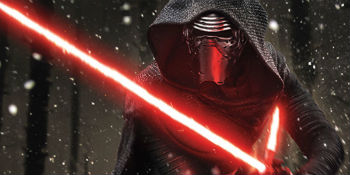 The Force Awakens wants to be all things: it wants to capture the sweaty exuberance of A New Hope as well as some of the darker, more tragic strains of The Empire Strikes Back. Accordingly, the second half of the movie is stuffed with several films’ worth of reversals, hellos and good-byes, and a flurry of to-and-fro as the characters are shuffled from planet to planet like pieces on a chessboard. When Lupita Nyong’o shows up as a CGI muppet to expound on the ways of The Force, you might wonder if the film has anything else up its sleeve besides regurgitations of past characters and events, and then you find out that there’s yet another Death Star (yeah, they call it Starkiller Base, but Han isn’t taken in by that B.S. — “How do we blow it up? There’s always a way to do that,” he grumbles). What it all lacks is an emotional throughline. Fixated on the big picture, preoccupied with all the narrative heavy lifting, lost in the thicket of all the references to Star Wars lore, Abrams loses sight of the fine details. We see the Starkiller Base eradicate five planets at once, and barely an eye is batted over the billions of lives lost. Poe becomes just another X-wing pilot making a run down a trench to blow up the enemy (yep, same old stuff, but less coherently shot this time). Kylo Ren has a confrontation with one of our heroes that should be emotionally charged given their history — too bad that the beef between them has been so vaguely sketched out that we can’t see the scene for anything other than what it actually is, an excuse for our hero to get killed off tragically so as to spur on our other protagonists. Most puzzling and out-of-the-blue is Rey’s transformation: for someone gifted with the Force but lacking formal training, she makes a good case for the superfluousness of Jedi masters, as she goes from zero to badass in the film’s home stretch with next to no reason. It’s one thing to detonate a Death Star, or showcase a pretty clashing of sabers — it’s another to provide straightforward, understandable character movement to make all the fireworks worthwhile.
The Force Awakens wants to be all things: it wants to capture the sweaty exuberance of A New Hope as well as some of the darker, more tragic strains of The Empire Strikes Back. Accordingly, the second half of the movie is stuffed with several films’ worth of reversals, hellos and good-byes, and a flurry of to-and-fro as the characters are shuffled from planet to planet like pieces on a chessboard. When Lupita Nyong’o shows up as a CGI muppet to expound on the ways of The Force, you might wonder if the film has anything else up its sleeve besides regurgitations of past characters and events, and then you find out that there’s yet another Death Star (yeah, they call it Starkiller Base, but Han isn’t taken in by that B.S. — “How do we blow it up? There’s always a way to do that,” he grumbles). What it all lacks is an emotional throughline. Fixated on the big picture, preoccupied with all the narrative heavy lifting, lost in the thicket of all the references to Star Wars lore, Abrams loses sight of the fine details. We see the Starkiller Base eradicate five planets at once, and barely an eye is batted over the billions of lives lost. Poe becomes just another X-wing pilot making a run down a trench to blow up the enemy (yep, same old stuff, but less coherently shot this time). Kylo Ren has a confrontation with one of our heroes that should be emotionally charged given their history — too bad that the beef between them has been so vaguely sketched out that we can’t see the scene for anything other than what it actually is, an excuse for our hero to get killed off tragically so as to spur on our other protagonists. Most puzzling and out-of-the-blue is Rey’s transformation: for someone gifted with the Force but lacking formal training, she makes a good case for the superfluousness of Jedi masters, as she goes from zero to badass in the film’s home stretch with next to no reason. It’s one thing to detonate a Death Star, or showcase a pretty clashing of sabers — it’s another to provide straightforward, understandable character movement to make all the fireworks worthwhile.
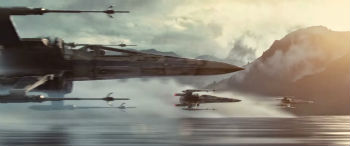 Some will say many of these curiosities and open ends will be explored in more detail in future entries, which just serves to underline the difficulty of the enterprise: rather than deliver a story that can be enjoyed as a self-contained entity, Abrams must be all about the set-up, and you can feel the strain. Abrams’ first Star Trek movie didn’t necessarily feel like Star Trek, but it was also rambunctious and playful, with clear progression for its characters. Fitfully stirring, mostly workmanlike, calibrated to fulfill audience expectations, The Force Awakens might be a reverent nod to what we expect from Star Wars, but you can also sense the pressure to conform to the template reigning in Abrams’ more adventurous instincts. The film’s concluding scene encapsulates its problems: we get a pretty, soaring crane shot of two central characters, but we’re no closer to understanding what they’re about, and how they’ve come to be who they are. As with every Abrams film, mysteries are dangled before us like candy, without guarantee that they’ll actually taste good when we finally get our hands on them. No wonder so many audience members and critics are impatient to see the next entry — they’re hoping that an explanation, any explanation, will be provided. “I have lived long enough to see the same eyes in different people,” says Nyong’o’s wizened Yoda stand-in; we recognize the glimmers of familiarity within the face of The Force Awakens, but as Star Wars marches on, it remains to be seen what lies behind that facade. Will we be greeted with something intriguing or surprising, or just more pale echoes of what has come before?
Some will say many of these curiosities and open ends will be explored in more detail in future entries, which just serves to underline the difficulty of the enterprise: rather than deliver a story that can be enjoyed as a self-contained entity, Abrams must be all about the set-up, and you can feel the strain. Abrams’ first Star Trek movie didn’t necessarily feel like Star Trek, but it was also rambunctious and playful, with clear progression for its characters. Fitfully stirring, mostly workmanlike, calibrated to fulfill audience expectations, The Force Awakens might be a reverent nod to what we expect from Star Wars, but you can also sense the pressure to conform to the template reigning in Abrams’ more adventurous instincts. The film’s concluding scene encapsulates its problems: we get a pretty, soaring crane shot of two central characters, but we’re no closer to understanding what they’re about, and how they’ve come to be who they are. As with every Abrams film, mysteries are dangled before us like candy, without guarantee that they’ll actually taste good when we finally get our hands on them. No wonder so many audience members and critics are impatient to see the next entry — they’re hoping that an explanation, any explanation, will be provided. “I have lived long enough to see the same eyes in different people,” says Nyong’o’s wizened Yoda stand-in; we recognize the glimmers of familiarity within the face of The Force Awakens, but as Star Wars marches on, it remains to be seen what lies behind that facade. Will we be greeted with something intriguing or surprising, or just more pale echoes of what has come before?

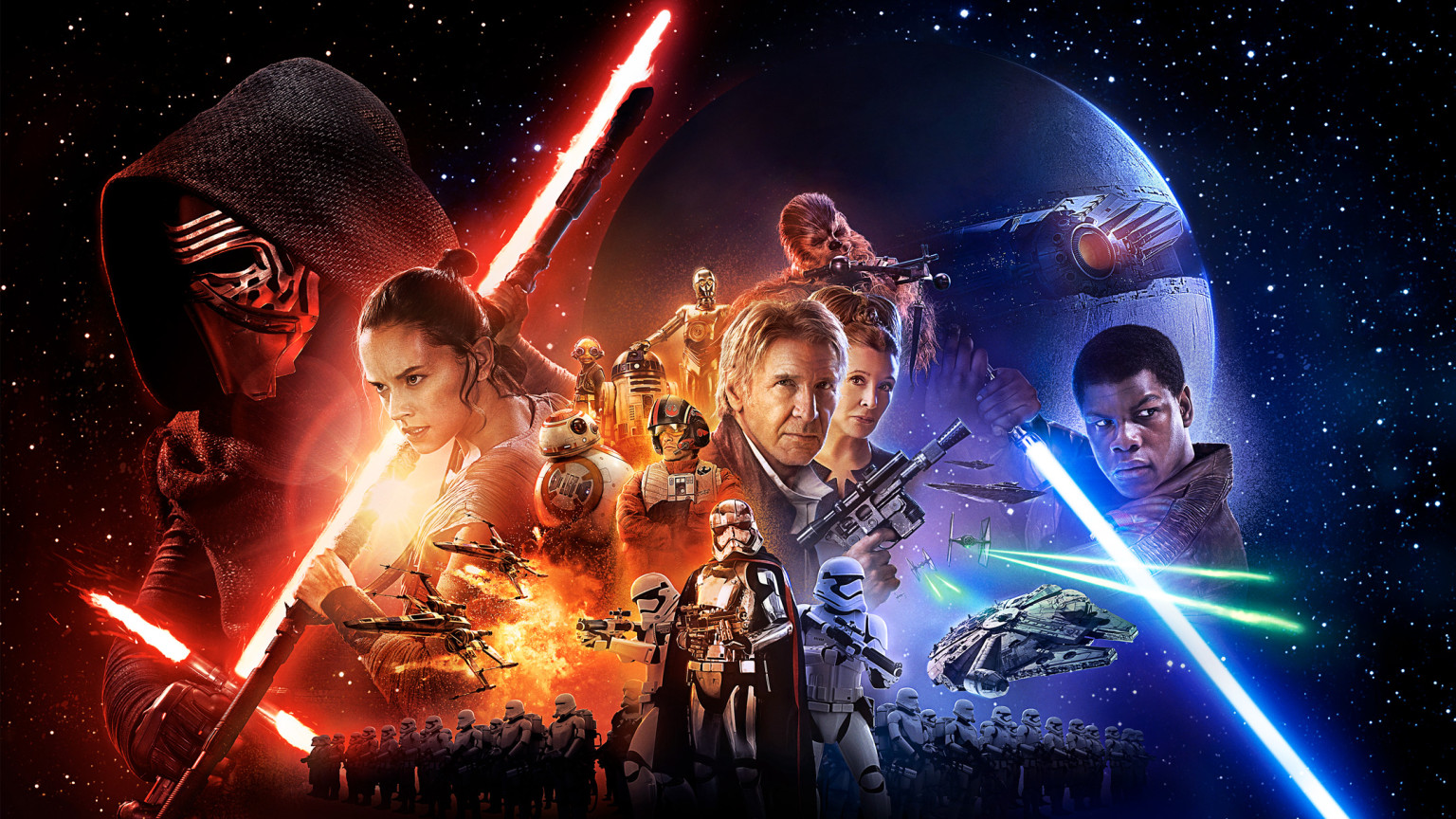
Comments
Jay
Good review. Mentioning the ending with Luke and Rey meeting atop a mountain (how cliche... Meeting a 'wise man' at the mountain top) where Rey […] Read MoreGood review. Mentioning the ending with Luke and Rey meeting atop a mountain (how cliche... Meeting a 'wise man' at the mountain top) where Rey holds out his light saber to him, I really wanted to see a closing shot of Luke from the waist up, close and suddenly you see the saber jump into his hand then cut to black. Would have been much cooler than an overhead rotating "majestic" shot. But that's kind of my biggest gripe with the whole movie. I wanted something more cool whatever that means. Something that grabs your balls. I liked Han being in it but for a lifelong smuggler rogue I wanted to see some of his old fierceness. Some determined focus aggression but he was palling around as you said. I had low expectations for this and really the main goal of this film was to resuscitate a franchise that could easily have put the whole thing into a coma which would have made Disney very sad. So I think the making a Star Wars movie that didn't suck was first and foremost. To that end I'd say mission accomplished but like you said it would be nice if the next installments begin to create a truly new Star Wars experience that has accomplished story telling with an emotional core with characters that you can love. Read Less
Jay
Good review. Mentioning the ending with Luke and Rey meeting atop a mountain (how cliche... Meeting a 'wise man' at the mountain top) where Rey […] Read MoreGood review. Mentioning the ending with Luke and Rey meeting atop a mountain (how cliche... Meeting a 'wise man' at the mountain top) where Rey holds out his light saber to him, I really wanted to see a closing shot of Luke from the waist up, close and suddenly you see the saber jump into his hand then cut to black. Would have been much cooler than an overhead rotating "majestic" shot. But that's kind of my biggest gripe with the whole movie. I wanted something more cool whatever that means. Something that grabs your balls. I liked Han being in it but for a lifelong smuggler rogue I wanted to see some of his old fierceness. Some determined focus aggression but he was palling around as you said. I had low expectations for this movie. Abrams benefited from Lucas' fuck up with the prequals. It gave Abrams some breathing room somewhat. Kind of like Obama riding into the presidency in the wake of disaster from Bush. Really the main goal of this film was to resuscitate a franchise that could easily have put the whole thing into a coma which would have made Disney very sad. So I think that making a Star Wars movie that didn't suck was first and foremost. To that end I'd say mission accomplished but like you said it would be nice if the next installments begin to create a truly new Star Wars experience that has accomplished story telling with an emotional core with characters that you can love. Read Less